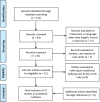Association of Cyberbullying and Internet Use Disorder
- PMID: 36160297
- PMCID: PMC9483413
- DOI: 10.1007/s40429-022-00440-9
Association of Cyberbullying and Internet Use Disorder
Abstract
Purpose of review: The purpose of this review is to critically assess the published studies on the relationship between cyberbullying and internet use disorder (IUD), and propose directions for further study.
Recent findings: There were only four prospective studies out of thirty-two reviewed studies conducted since 2004, with only one prospective study conducted during the past 5 years. The field of study has been stagnant during the past 5 years with the vast majority of studies conducted on primary or secondary education and failing to address cyberbullying and IUD in social media and online gaming.
Summary: Cyberbullying and IUD have been described since the nineties, yet there are still significant issues with their definition and research. Lately, both these problematic behaviors are sharing the same environments in social media and online gaming. This critical appraisal of published research examined thirty-two published peer-reviewed studies carried out since 2004. Findings indicate a number of significant issues including an overreliance on cross-sectional study design, near-exclusive focus on primary and secondary education students, widespread employment of unstandardized measures for cyberbullying and IUD, and lack of assessment for objective measures of psychological distress. Directions for future research are offered.
Keywords: Cyberbullying; Internet gaming disorder; Internet use disorder.
© The Author(s), under exclusive licence to Springer Nature Switzerland AG 2022, Springer Nature or its licensor holds exclusive rights to this article under a publishing agreement with the author(s) or other rightsholder(s); author self-archiving of the accepted manuscript version of this article is solely governed by the terms of such publishing agreement and applicable law.
Conflict of interest statement
Conflict of InterestThe authors declare no competing interests.
References
-
- Hinduja S, Patchin JW. Cyberbullying research summary. Dev Psychol. 1998;34(2):299–309. - PubMed
-
- Tokunaga RS. Following you home from school: a critical review and synthesis of research on cyberbullying victimization. Comput Hum Behav. 2010;26(3):277–287. doi: 10.1016/j.chb.2009.11.014. - DOI
-
- Watts LK, Wagner J, Velasquez B, Behrens PI. Cyberbullying in higher education: a literature review. Comput Hum Behav. 2017;69:268–274. doi: 10.1016/j.chb.2016.12.038. - DOI
Publication types
LinkOut - more resources
Full Text Sources
Research Materials
Miscellaneous

